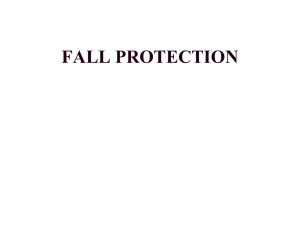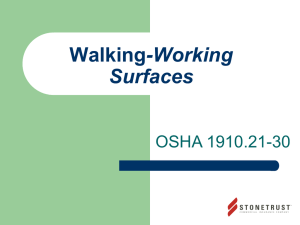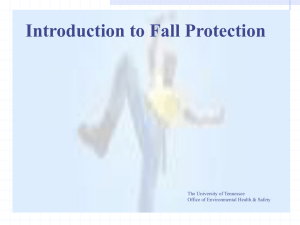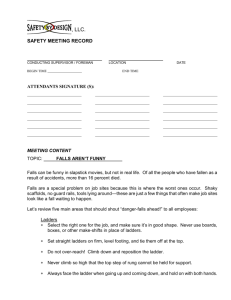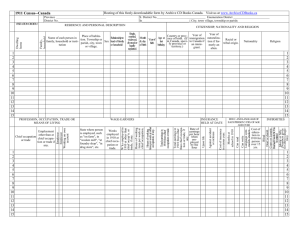Subpart D Walking/Working Surfaces (The following slides only
advertisement
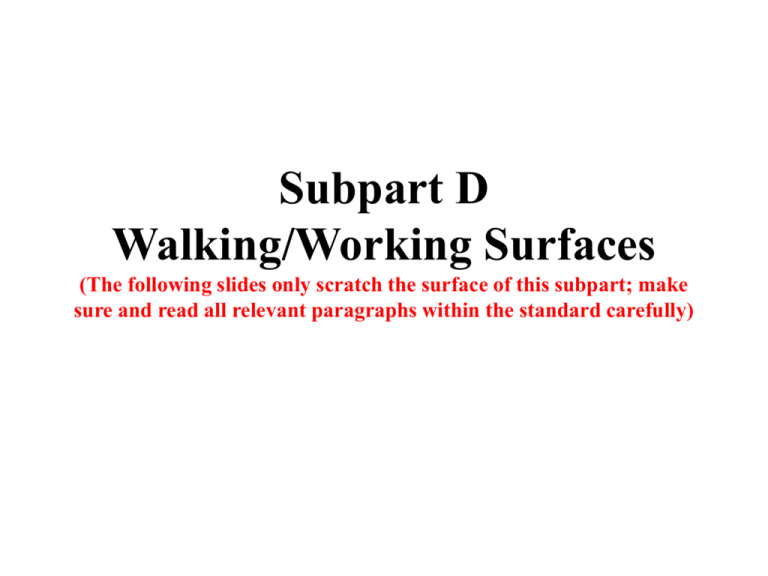
Subpart D
Walking/Working Surfaces
(The following slides only scratch the surface of this subpart; make
sure and read all relevant paragraphs within the standard carefully)
Sections
•
•
•
•
•
•
•
•
•
•
1910.21
1910.22
1910.23
1910.24
1910.25
1910.26
1910.27
1910.28
1910.29
1910.30
Definitions
General requirements
Guarding Floor and Wall Openings
Fixed Ind. Stairways
Portable Wood Ladders
Portable Metal Ladders
Fixed Ladders
Scaffolds
Mobile Scaffolds Ladder Stands
Other Working Surfaces
ANSI Standards
• ANSI 10.8
Scaffolding
• ANSI 12.1
Railing
• ANSI 14.1
Wood Ladders
• ANSI 14.2
Metal Ladders
• ANSI 14.3
Fixed Ladders
Hazards Associated With
Walking and Working Surfaces
• Slips
• Trips
• Falls from Same Level
• Falls from Height
• Material Handling
• Means of Egress
• Fire
Injuries
• Contusions
• Broken Bones
• Fractures
• Concussion
• Death
• Back Injury
• Strains and Sprains
Causes
• System Overload
• Instability
• Improper Selection and Use of Equipment
• Inadequate Maintenance and Repair
• Departure from Manufacturer’s Specifications
• Other
Subpart D - Continued
• Slips and Falls, VTO 1348, 1988, Audio Visual
Loan Service
1910.21 - Definitions
• (a)(1) – Floor hole: <12”&>1”
• (a)(2) – Floor opening: > 12” in least
dimension
• (a)(10) - Wall hole: <30”&>1”high
• (a)(11) - Wall Opening 30” H18”W
1910.22 – General Requirements
•
(a) Housekeeping (Clean, Orderly, Sanitary)
(1) All places of employment; passageways;
storerooms; service rooms
(2) Floors
Clean & Dry
Wet processes used:
# Drainage maintained (Shall)
# False floors, platforms, mats, dry
standing places (Should)
1910.22 (Continued)
• (b) Aisles & Passageways
(1) Safe clearances/Clear & good repair/ No
obstructions in aisles
(2) Aisles/passageways marked
• (c) Covers & Guardrails
Open pits, tanks, vats, ditches, etc.
1910.22 (Continued)
• (d) Floor Loading Protection
(1) Every building, structure, part
Mercantile, business, industrial, storage
Loads approved by building official
Marked & affixed in conspicuous place
(2) Unlawful to overload
1910.23 – Guarding Floor/Wall
Openings
• (a) Floor Openings
(1) Stairway floor openings – guarded by standard
railing
(2) Ladderway floor openings/platforms-guarded by
standard railing/toeboard
(3) Hatchway/chute floor opening – guarded by
hinged cover or removable railing/toeboard
(4) Skylight floor opening/hole – guarded by
standard skylight screen of fixed standard railing
(5) Pit and trap opening-cover/attendant/railing
1910.23 (Continued)
(6) Manhole floor opening – guarded by standard
manhole cover
(7) Temporary floor opening – guarded by standard
railing
(8) Floor hole opening – guarded by standard railing or
floor hole cover
(9) No openings>1” on floor holes
1910.23 (Continued)
• (b) Wall Openings/Holes
(1) Drop>4’ shall be guarded by:
(i) Rail, roller, picket fence, half door/equivalent
barrier
• (c) Open Sided Floors, Platforms, Runways
(1) 4’ or more above ground – guarded by standard railing
(3) Adjacent to Dangerous Equipment (regardless of
height) – guarded by standard railing/toeboard
1910.23 (Continued)
• (d) Stairway Railings & Guards
(1) 4 or more risers: standard stair railings
(i) < 44” W/both sides enclosed:
handrail right side descending
(ii) < 44” W/one open side: at least one
railing on open side
(iii) < 44” W/both sides open: stair railing
each side
(iv) > 44” W but < 88” W: handrail on
enclosed sides/stair railing on open sides
(v) 88” W rail down center of stairway: Handrail
enclosed/stair rail open sides
1910.23 (Continued)
• (e) Railing, Toeboards & Covers
(1) Standard railing
Top rail: smooth surface; 42”H
Intermediate rail
Posts
(2) Stair Railing (similar to standard railing)
Top rail not >34” nor <30”
(4) Standard Toeboard: 4” nominal height
1910.24 – Fixed Industrial Stairs
• (b) Fixed Stairs Required:
Access from one level to another
Where operations require regular travel
between levels
Access to operating platforms
Access to elevations daily/at each shift for:
+Inspections
+Gauging
+Regular maintenance, etc.
1910.24 (Continued)
• (c) Stair Strength
5 times normal live load anticipated, but
Never <strength to safely carry moving
concentrated load of 1,000 lbs.
• (d) Stair Width
Minimum width of 22”
• (e) Angle of Stairway Rise: Table D-1
1910.24 (Continued)
• (f) Stair Treads
Slip resistant
Nosings of nonslip finish
• (g) Stairway platforms
No less than width of stairway
Minimum of 30” L
1910.24 (Continued)
• (h) Railings & Handrails
Standard railings: open sides of exposed stairways
& stair platforms
In accordance with 1910.23
• (i) Vertical Clearance
7’ to overhead obstruction from tread
1910.25 Portable Wood Ladders
• (b) Materials
(1) Requirements applicable to all wood parts
(i) No sharp edges/splinters
No low density wood construction
Free from shake/wane/decay/
compression failure
1910.25 (Continued)
• (c) Construction requirements
(2) Portable stepladders
Longer than 20’ not permitted
3 types
+Type I: Industrial; 3-20’
+Type II: Medium Duty; 3-12
+type III: Light Duty; 3-6
1910.25(c) – (Continued)
• (c)(2)(i) General Requirements
(b) Uniform step spacing not >12”
(c) Not <11 ½” minimum width between side
rails
(3) Portable Rung Ladders
(ii)(a) Single ladder: not longer than 30’
(iii)(a) Two section ladder: not longer than 60’
(4) Special Purpose Ladders
(ii)(a) Painters stepladder: not longer than 12’
(iii)(a) Mason’s ladder: not longer than 40’
(5) Trolley & Side-Rolling Ladders
(i) Not longer than 20’
1910.25 (Continued)
• (d) Care & Use of Ladders
(1) Care
(i) Good condition
(iv) Safety feet/auxiliary equipment: good
condition
(x) Inspected frequently, if defective, withdrawn
from service for repair or destruction
(xi) Rungs kept free of grease & oil
1910.25 (continued)
• Other care and use issues
– Ladder stable or held or latched in place
– Tops of step ladders shall not be used
– Top of ladder extend 3’ above support
– Ladder angle: ladder base located ¼ the working
length from the vertical support
– Manufacturer’s Specifications
1910.26 – Portable Metal
Ladders
• (a) Requirements
(1) General
(iii) Rung spacing: 12” centers
(2) Straight/extension ladders
(i) Minimum width between side rails: 12”
(ii) Length single/individual ladders: not
>30’
Two section ladders: not >48’L
Over two section ladders: not>60’L
1910.26(a) – (Continued)
• (a)(3) Step Ladders
(iii) Not > 20’L
(4) Trestles/Extension Trestle Ladders
(i) Not >20’L
(5) Platform Ladders
(i) Not >20’L
1910.26 – (Continued)
• Refer to 1910.333 Working on or near exposed
energized parts
– ( c)(7) Portable Ladders
• Portable ladders shall have nonconductive siderails
1910.27 – Fixed Ladders
• (b) Specific Features
(1) Rungs & Cleats
(i) Metal ladders: minimum diameter ¾”
Wood ladders: minimum diameter 1 1/8”
Where corrosion/rusting: minimum
diameter 1” or painted {27(b)(7)(i)}
(ii) Distance between rungs: 12”
(iii) Minimum length of rungs between side rails:
16”
• (c) Clearances
(4) In back of ladder: not < 7”
1910.27 – (Continued)
• (d) Special Requirements
(1) Cages or Wells
(ii) Provided on ladders > 20’ to maximum 30’L
(iv) Cages extend down ladder not < 7’ or> 8’
above base of ladder
(2) Landing Platforms
Ladder with cage: for each 30’H
Ladder/no cage: for each 20’H
(5) Ladder safety devices may be used in lieu of cages on towers,
water tanks, and chimney ladders. No Landing platform is
required in these cases.
1910.28 – Safety Requirements
for Scaffolding
• (a) General: all scaffolds
(2) Sound, rigid footing (anchorage)
(4) Capable of supporting 4 X maximum intended load
(11) Planking/platforms overlapped minimum 12”
(12) Access ladder/equivalent provided
(13) Scaffold planks extend:
From end supports
Not less than 6”
Not more than 18”
(17) Screen between toeboard & guardrail
(22) Wire rope/scaffold suspension
Supporting 6X intended load
1910.28 – Safety Requirements
for Scaffolding
• Fall Protection:
– Standard Guardrailing
– Personal Fall Arrest System (Subpart M 1926)
1910.28 - Continued
• (b) General Requirements Wood Pole Scaffolds
• (c) Tube and coupler scaffolds
• (d) Tubular welded frame scaffolds
• (e) Outrigger scaffolds
• (f) Masons’ adjustable multi-point suspension scaffolds
• (g) Two-point suspension scaffolds
• (h) Stone setters’ adjustable multi-point
suspension scaffolds
1910.28 - Continued
•
•
•
•
•
•
•
•
•
(i) Single-point adjustable suspension scaffold
(j) Boatswain’s chair
(k) Carpenters’ bracket scaffolds
(l) Bricklayers’ square scaffolds
(m) Horse scaffolds
(n) Needle beam scaffold
(o) Plasterers’ and large area scaffolds
(p) Interior hung scaffolds
(q)….(u)
1910.28 - Continued
• “A Basic Look at Scaffolds for Compliance
Officers”, VTO 1259, 2000 (Audio Visual Loan
Service)
• Corresponding Subpart in 1926 Construction:
Subpart L
• Competent Person
1910.29 – Manually Propelled
Mobile Ladder Stands and
Scaffolds
• General Requirements:
– No Sharp Edges
– Stable
– Guardrails and Toeboards work levels 10 feet
1910.30 – Other Working
Surfaces
• (a) Dockboards (Bridge Plates)
(1) Strong enough to carry load
(2) Portable dockboards
Secured in position
Anchored/equipped with anti-slip devices
(4) Handholds/other means for portable dockboards
(5) Positive protection/prevent railroad car movement
while dockboards/bridge plates in position
